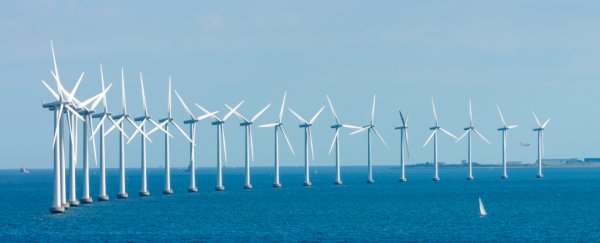Denmark produced an unheard-of 42 percent of its electricity from wind turbines in 2015, according to official figures, setting a new world record for wind energy generation.
The Scandinavian country has gone from strength to strength when it comes to the renewable energy source, with 2014 seeing it generate 39.1 percent of its energy from wind turbines. The government now has its sights firmly set on producing half of all its electricity from wind by 2020.
Even more impressive is the fact that certain regions in Denmark's west produced more wind energy than they could consume for the equivalent of 60 days of the year. On one particularly windy day in July, the country produced 140 percent of its electricity demands from its wind turbines, and was able to sell the excess off to Germany, Norway, and Sweden.
Then, on September 2, Denmark was able to operate without any central power stations being switched on at all, relying instead on wind power and renewable energy bought from neighbouring countries.
And did we mention that they did all of that despite the fact that two of their major wind farms were offline for a total of three months during the year due to cable faults?
"Hopefully, Denmark can serve as an example to other countries that it is possible to have both ambitious green policies with a high proportion of wind energy and other renewables in the energy supply, and still have a high security of supply and competitive prices on electricity," the country's minister for energy, utilities and climate, Lars Christian Lilleholt, told The Guardian.
To be fair, the main reason 2015 was so successful for Denmark is because it just so happened to be really, really windy. But the amount of wind power electricity generated in the country has gone up each year since 2008, even in years with normal wind conditions, such as 2014, which suggests that the system is definitely working.
In fact, if the two offline wind farms at Anholt and Horns Rev had been up and running the whole year, the country's wind power would have been made up of approximately 43.5 percent of the country's electricity last year, according to Energinet, the national electricity operator in Denmark.
But just because 42 percent of the country's electricity overall came from wind power, that doesn't mean that every single home was running on wind-generated electricity each day - the grid doesn't quite work like that.
Energinet explains that energy is constantly being traded between countries, with Germany, Sweden, and Norway buying Denmark's wind power, and Denmark buying back nuclear power back from Sweden, solar power from Germany, and hydropower from Norway. It's that trading system that helps the country to provide continuous, reliable power throughout the day and night.
The distribution of wind turbines within the country is also uneven, with the majority located in the west of the country. That meant that in western Denmark, 55 percent of electricity was generated from wind power, while in the east only 23 percent was. In the east, wind production also never exceeded total electricity consumption.
Still, the country is continuing to build wind turbines, and it's determined to get closer to its goal of weaning at least half the grid off of fossil fuels for good in the next four years. The rest of the world should take note.
